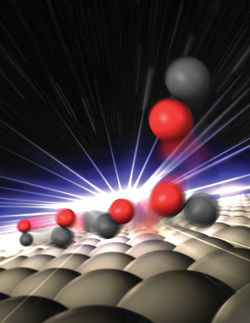Lead-free piezoelectric materials of the future
Piezoelectric materials have fantastic properties: squeeze them and they generate an electrical field. And vice-versa, they contract or expand when jolted with an electrical pulse. With a name derived from the Greek word meaning to squeeze or press, the piezoelectric effect was just a curiosity after it was discovered in several crystals in 1880. But in 1917, a quartz piezoelectric crystal was at the heart of the world's first submarine-detecting sonar. Piezoelectric materials really took off after the 1950s, with the development of a superior man-made piezoelectric ceramic crystal: lead zirconate titanate, or PZT (the initials of its chemical symbols). Over the past 60 years, PZT has been essential for myriad high-tech applications: from inkjet printers to digital camera shutters, ultrasonic imagers, fuel injector actuators, and igniters for gas barbecue grills.
Despite this success, many scientists now want to replace PZT with some as yet undiscovered lead-free material that would be more environmentally benign and that would enable new piezoelectric applications in biological settings. To date, however, no suitable successors have been found. Candidates are typically too feeble in their piezoelectric effect and/or physical durability.
A Swiss scientist, Dragan Damjanovic, thinks researchers should be looking more broadly. He says nearly all of today's efforts are focused on materials whose ions and electrons - the ultimate source of the piezoelectric effect - behave in a particular manner, called polarization rotation. His theoretical calculations have shown that another, overlooked behavior – polarization extension, present in other classes of materials - can also generate an enhanced piezoelectric effect.
An article by Damjanovic in the journal Applied Physics Letters details his ideas and supporting evidence. In particular, he proposes a particular type of phase diagram that he believes will lead to improved, lead-free piezoelectric materials.
Original publication: Dragan Damjanovic; "A morphotropic phase boundary system based on polarization rotation and polarization extension"; Applied Physics Letters 2010.
Most read news

Get the analytics and lab tech industry in your inbox
By submitting this form you agree that LUMITOS AG will send you the newsletter(s) selected above by email. Your data will not be passed on to third parties. Your data will be stored and processed in accordance with our data protection regulations. LUMITOS may contact you by email for the purpose of advertising or market and opinion surveys. You can revoke your consent at any time without giving reasons to LUMITOS AG, Ernst-Augustin-Str. 2, 12489 Berlin, Germany or by e-mail at revoke@lumitos.com with effect for the future. In addition, each email contains a link to unsubscribe from the corresponding newsletter.
























































